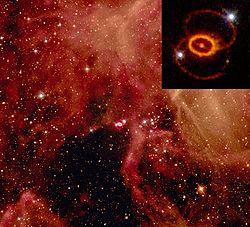SN1987ALightCurve
Autor/Urheber:
Attribution:
Das Bild ist mit 'Attribution Required' markiert, aber es wurden keine Informationen über die Attribution bereitgestellt. Vermutlich wurde bei Verwendung des MediaWiki-Templates für die CC-BY Lizenzen der Parameter für die Attribution weggelassen. Autoren und Urheber finden für die korrekte Verwendung der Templates hier ein Beispiel.
Shortlink:
Quelle:
Größe:
1500 x 975 Pixel (91830 Bytes)
Beschreibung:
A V band light curve for SN 1987A. The inset plot shows the time near peak brightness.
Lizenz:
Credit:
Eigenes Werk mittels: Plotted from data published by:
- Allen, W. H. (1987). "Three colour observations of SN1987A". Publications of Variable Star Section 14: 82-84. Royal Astronomical Society of New Zealand.
- Suntzeff, N. B. (December 1988). "SN 1987A in the LMC. II - Optical photometry at Cerro Tololo". Astronomical Journal 96: 1864. ISSN 0004-6256.
- Catchpole, R. M. (November 1987). "Spectroscopic and photometric observations of SN 1987a–II. Days 51 to 134". Monthly Notices of the Royal Astronomical Society 229 (1): 15–25.
- Fransson, C. (March 2007). "Twenty Years of Supernova 1987A". The Messenger 127: 44.
Relevante Bilder

(c) NASA, ESA, CSA, M. Matsuura (Cardiff University), R. Arendt (NASA’s Goddard Spaceflight Center & University of Maryland, Baltimore County), C. Fransson (Stockholm University), J. Larsson (KTH Royal Institute of Technology), A. Pagan (STScI), CC BY 4.0


(c) ESA/Hubble, CC BY 4.0
Relevante Artikel
SN 1987ASN 1987A ist die erdnächste Supernova, die seit der Supernova 1604 beobachtet werden konnte. Sie wurde am 24. Februar 1987 entdeckt und fand in der Großen Magellanschen Wolke (GMW) statt. Diese ist etwa 48.000 ± 5.000 Parsec entfernt, was rund 157.000 ± 16.000 Lichtjahren entspricht. .. weiterlesen
